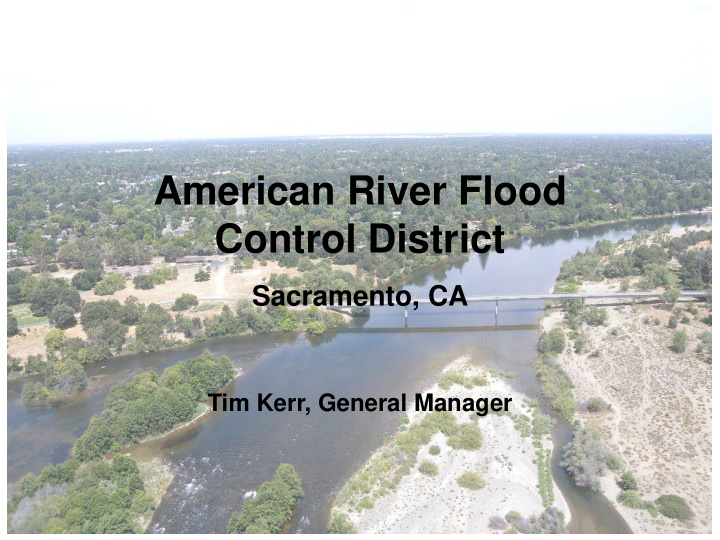



American River Flood Control District Sacramento, CA Tim Kerr, General Manager
American River Flood Control District • Established in 1927 • Operates and Maintains 40 miles of flood control levees in Sacramento • American River, Steelhead Creek, Arcade Creek, Robla Creek, Dry Creek • Activities include: – Vegetation control, mowing, pruning, herbicide application – Roadway maintenance, gates, fencing – Encroachment control – Slope stabilization, erosion repairs – Rodent abatement – Continuous levee monitoring – Flood patrolling and flood fights
American River Flood Control District • Major urban setting • Immediately downstream of Folsom Reservoir • Adjacent to the American River Parkway • 1000 residential neighbors
ARFCD Levees
USACE 2010 Periodic Inspections • 1 South Basin • 3 North Basins Results: South Basin – American River/City of Sacramento/MA9 – Some unacceptable rated items downstream of ARFCD – Collaborated to submit a Letter of Intent – Submitted the Final System Wide Improvement Framework December 2017 3 North Basins – Minimally Acceptable
USACE 2016 Continuing Eligibility Insp. • 3 Northern Basins Results: • No USACE report yet – staff communication indicates all yellow rated items have turned pink (Not corrected within 2-years) • ARFCD is finalizing a Letter of Intent to develop a SWIF. Received two rounds of comments from USACE .
Main Challenges for PL84-99 Eligibility • Levee Pipe penetrations • Rodent abatement • Hazardous vegetation • Encroachments • Easements/Access • Homeless camps
Levee Pipe Penetrations • DWR Utility Crossing Inventory Program identified 189 ‘found’ pipes in ARFCD • USACE wants all pipe penetrations video inspected at least once every 5-years • ARFCD doesn’t own any active pipes • All but one of the pipe owners are public entities: – City of Sacramento – interior drainage, water supply – County of Sacramento – interior drainage, sewer – Regional Sanitation – sewer – Sac Suburban Water District – water supply – CalTrans - drainage – PG&E – gas • One private pipe penetration owner: – Kinder-Morgan – liquid petroleum
Rodent Abatement • Active rodent abatement program that complies with the USACE O&M Manual – Smoke Bombs in early spring – Pesticide bait stations throughout summer – Live trapping throughout summer – Repair all burrowing damage prior to start of flood season – Remove food supply where possible • Despite repeating this practice every year, no noticeable change in rodent population or burrowing damage
Hazardous Vegetation • ARFCD removes trees that show signs of disease or declining health – Dead branches – Falling limbs – Fungus – Rot • Safety of workers and public • Prevent toppling and displacement of soil from root ball • Remove hazardous trees during time of convenience not during a flood event • Remove roots and recompact levee soil
Encroachments, Easement, Access • Where we have toe roads, we have no problems – Very low occurrence of encroachments – Most any levee problem can be addressed with routine O&M • Where we don’t have toe roads, we see a constant battle to hold encroaching forces at bay – High number of encroachments (misperception that the levee is an extension of the resident’s backyard) – No toe road to support repair equipment, access, and staging – Specialty equipment must be used – Often repairs require more of a capital project than an O&M solution
Landside Encroachments • Decorative vegetation • Landscaping and pavers • Irrigation • Vegetable gardens • Terracing and retaining walls • Fences outside the property line • Stairs
Homeless Camps • Problem is exploding like we have never seen before • Prior to 2015, isolated camps that were entrenched • In the last 3 years, camping sites have multiplied by a factor of 5-10 – Much more widespread – Numerous camps/tents linked together – Extreme excavations for tents and walkways – Trash, debris, hazardous materials – Loose dogs, unpredictable individuals, altercations • ARFCD now has to coordinate with City/County authorities to evict campers in order to perform maintenance work • Damage repairs at reoccurring sites are repeated in an ever increasing frequency
Questions
Recommend
More recommend